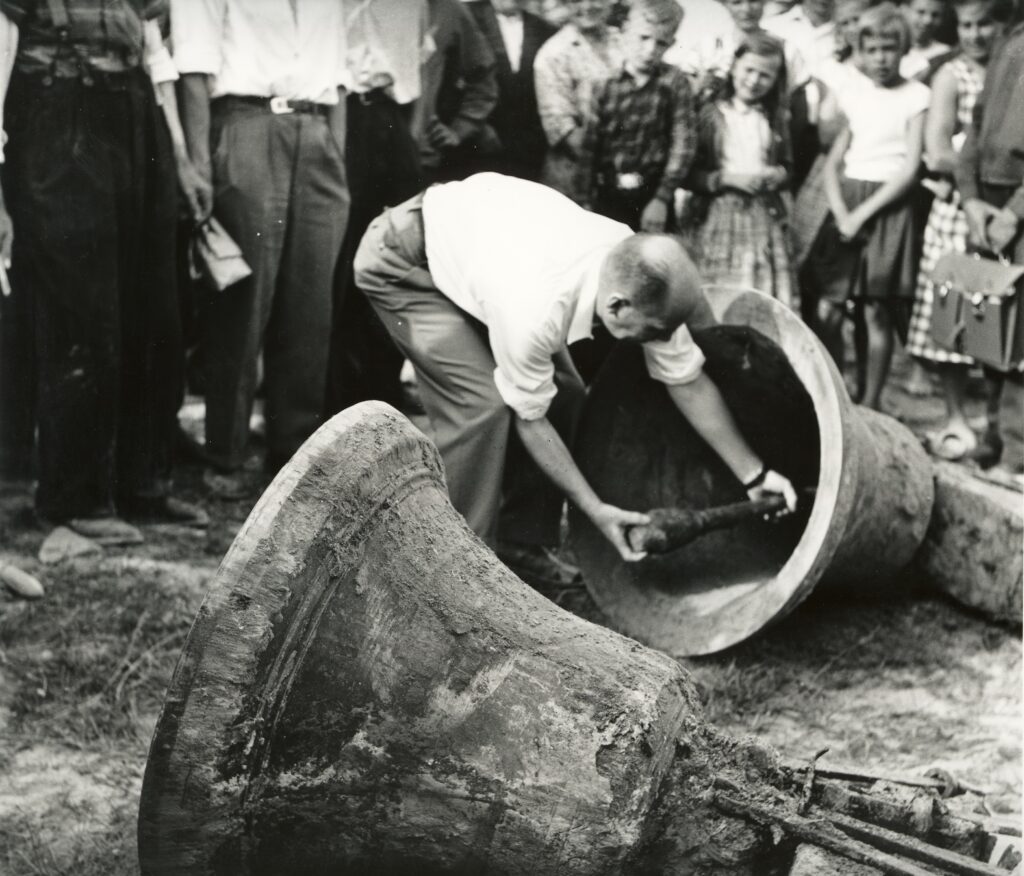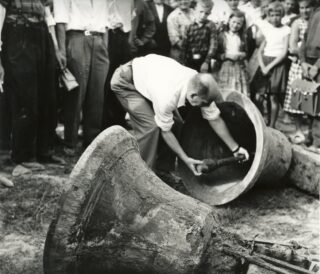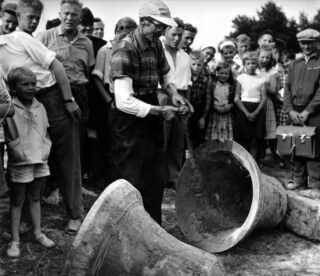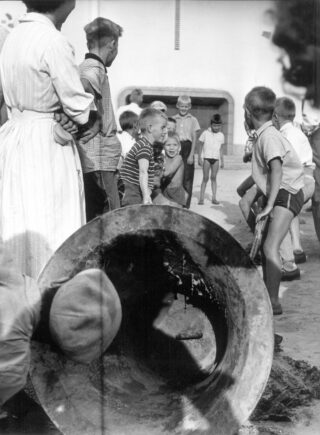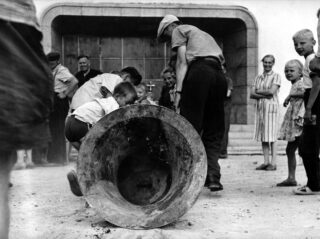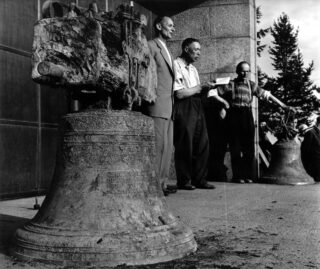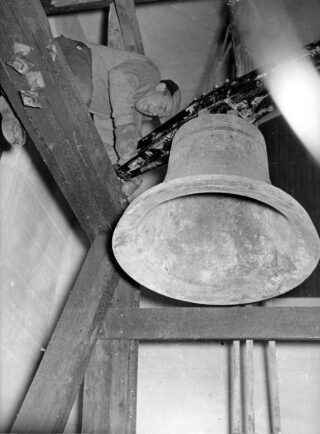The border guard Saria was ordered to carry out investigations until 4 pm, and since there was still time left, it was decided to move to the German cemetery on the northwest side of the church. The entire area didn’t even have time to be swept, when minesweeper gave the alarm about metal in the corner of the cemetery on the Street Kirkkokatu side, roughly in the eastern corner of the cemetery, a few tens of meters away from the church. At first, the sweeper reported that there was relatively little metal, but after a check and a new sweep, the deposit was already stronger. The gravedigger Kurvinen’s rod also met metal, which at first felt like stone, only a few tens of centimetres deep. Additional pokes revealed the shapes of the bells. Additional labour arrived to help with the digging, and soon the beautiful shape of the church bells and the green colour with a slight hint of mould could be seen by dozens of Kuusamo residents and a few tourists who happened to be there. The bells were found on Monday, July 20th, at 4 pm, only a few tens of centimetres deep.
When the bells were unearthed, the locals began to suspect that they might have been mined. When a strangely shaped object appeared during the excavation, many mistakenly thought it was a mine. However, the former pioneers who were there said that the German troops were not supposed to have mines of that type at that time. The object turned out to be a reinforced shaft end of a bell. When both bells had been brought out, they were pulled up from the mount by car, so that bellringer Kalle Raatesalmi and sacristan Palosaari, along with others, could check their condition. It turned out to be excellent. The tongues of the bells were carefully tested, revealing that there were no cracks in the bells. They had been taken down from the belltower very carefully and hidden on the ground just as carefully. The wooden parts of the bells’ brackets had rotted, and the iron parts were badly rusted, but the silvery metal was in such good condition that one would think the bells had only been on the ground for a few months.
Gravedigger Niilo Kurvinen told Koillissanomat the following:
“At first, it felt like stone had hit the iron rod. Even the minesweeper didn’t report anything but a very small area, and at that time we thought that it was just more metal-rich stone or a piece of iron from the remains of the old church. To our disappointment, the objects found by the minesweeper were always like that. However, when the minesweeper was checked and it announced that a larger amount of metal was in question, I examined the place more closely with an iron rod and it started to take the shape of a bell. A stab of the shovel into the ground brought the board into view and there they were.”
The bells were pulled by hand to the steps of the church – the most enthusiastic pullers were the little boys. The word spread quickly, and more locals arrived, talking to each other about the bells. After the bells were found, a simple field prayer was held at 6 pm on the church steps in honour of what happened. Under the leadership of cantor Lauri Marttinen, the parishioners sang the hymn “Ajast’aikaan varjellut, olet Herra kirkkoamme”. After that, vicar Poukkula gave a short speech, mentioning, among other things, that on that day almost 15 years had passed since the bells had last called parishioners to church. Finally, the vicar said that he hopes the bells will serve parishioners from generation to generation long into the future. At the end, the hymn “Herraa hyvää kiittäkää” was sung. Many parishioners from further afield visited the same day to admire the found bells.
It was decided to donate the largest and medium-sized of the church’s new bells to the Käylä church, and in their place, the newly found bells would be hoisted into the church town’s church. They also wanted to erect a modest memorial at the place where the bells were found. At first, the bells were kept on the steps of the church entrance, where people could come and see them.
On the evening of the day the bells were found, STT’s 7 pm news gave the following announcement:
“Kuusamo’s old church bells, which had been missing for 15 years, were found this afternoon in their hiding place in Kuusamo’s churchyard near the graves of German Heroes’ Cemetery. Searches for the church bells had been carried out since last Wednesday, when a former German colonel, who had learned the whereabouts of the bells, stopped by on his vacation to tell the vicar of Kuusamo his information. The bells were in good condition when found. They had been dug 20 centimetres deep into the ground.”
Saria, a border soldier who was involved in the search for church bells, received a free priest’s certificate in Kuusamo – which at that time cost 40 pennies – when she married Kerttu Talala. On the first Sunday of August, Kerttu and Antti Saria posed as a newlywed couple for a photographer on the steps of the new church in Kuusamo, next to the bells. Scheiber and his entourage were also informed of the discovery of the bells, and the news spread so widely through the newspapers that the “Kuusamo men” were recognized all over Finland based on the German license plates of their cars. Photographs were taken of the Germans, and, in Scheiber’s words, a “wave of sympathy” passed in front of them. The former colonel later found out that the search was delayed, because his comrade had forgotten to mention that the bells were in the Heroes’ Cemetery, not in the general cemetery. Scheiber himself had not been involved in burying the bells.
The discovery of church bells was considered one of the most extraordinary cases in Finnish church history. Church bells have been hidden before during the persecutions, but rarely have they been found afterwards. Kuusamo’s bells would have been found sooner or later, because soon after the discovery, the German graves were opened to transfer the dead to the mausoleum built in the rural municipality of Rovaniemi.
